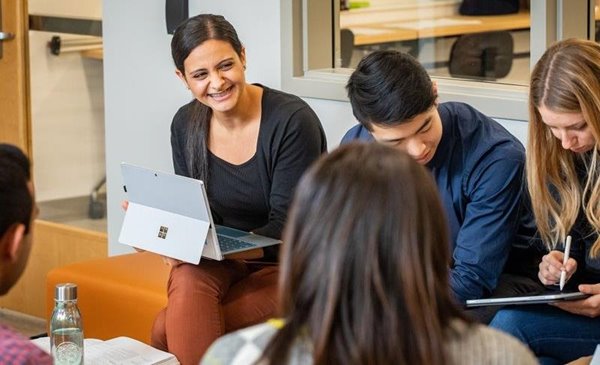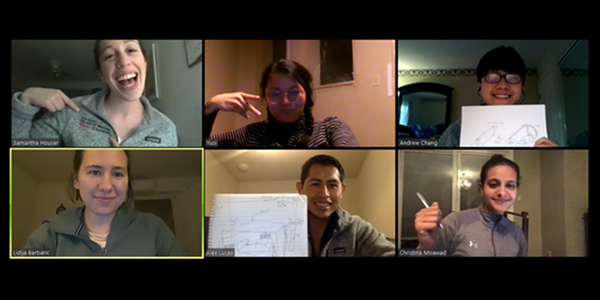For Christina Moawad, there was no question that she would do whatever she could to help fight the COVID-19 pandemic. Born and raised in New York City and with a majority of her immediate family serving in healthcare, she saw the need early on for new solutions, extra hands, and a quick response.
When one of her classmates shared an opportunity to participate in the Johns Hopkins COVID-19 Virtual Design Challenge, Christina and her classmates jumped at the chance. After conversations with her sister, an ICU nurse in a New York City hospital, her group’s contribution to the COVID-19 response became clear: reduce the need for personal protective equipment (PPE).
 Moawad and five other classmates set out to tackle the global shortage of PPE. A weekend-long event, the group worked around the clock to design their solution.
Moawad and five other classmates set out to tackle the global shortage of PPE. A weekend-long event, the group worked around the clock to design their solution.
“The resources they had were incredible. We would think of a problem, and when we realized we didn’t know how something would work, we could look up an expert, email them, and within an hour or two we’d have a time to talk with them,” she said.
Yet while her team’s concept developed, so did the dire situation in New York. As the city became inundated with COVID-19 cases, Moawad saw her four siblings—an ICU nurse, a physician assistant, an ICU doctor, and a first year resident—fight on the front lines to help. The team set up Zoom calls with them, and were able to hear the clinical challenges they faced in real-time. But the situation hit even closer to home when an immediate family member and additional family members became infected with COVID-19.
“I don’t know a single person in New York who hasn’t been affected. I would wake up every morning scared, thinking, “Who passed away today?” Moawad said.
While Christina was in New York, she and her team continued to develop the COVI-Pod concept. “It was a really big team effort with all six of us working on different aspects of the project, from detailed design, CAD drawings, and contacting manufacturers,” she said. They pitched their concept to Carle Health physicians and University of Illinois Urbana-Champaign professors, soliciting advising support as they continued pursuing the project.
“Engineering and medicine combine to solve our most timely problems. The students embody the creativity that we need in ever changing times,” Mark Johnson, MD, Critical Care said.
The Carle Illinois community extends nationally to help solve the global problems like those facing us with COVID-19 today.
“The rapid collaboration and creativity that was shown here shows where we shine,” Dr. Johnson said. The needs will continue in unpredictable ways but I’m confident in our abilities to keep up. There’s no place I’d rather be as a physician, educator, or human right now. Our ability to express ourselves and care for each other in a positive way has really helped during this troubled time.”
Dr. Johnson said while it’s hard to keep up in these ever changing times, coming together on proactive solutions helps us to make sense of this world and can even help make sense of what’s happening to our own friends and families.
“I’m thankful I got to see (my family) go through it. People look up to these doctors. It helps me think how I’m going to be when I’m faced with similar challenges,” Moawad said.
While her immediate family member has fully recovered and returned to work, she and her classmates continue to think through ways to transition the COVI-Pod concept to an everyday hospital setting, where healthcare professionals can perform low acuity tasks without having to enter the ICU room. This could lower the patient’s exposure to disease, and it can save PPE and the invaluable resource of time.
“The whole mission of our school at a time like this is so fitting. It feels like we were always preparing to one day become physician-innovators, and when we get our degree, then we will be ready. But when we heard the problem and wanted to help, we were like, “This is kind of our time,” she said.
Categories: Redefining Healthcare
Tags: Carle Illinois, college of medicine, innovation, medical students, research
